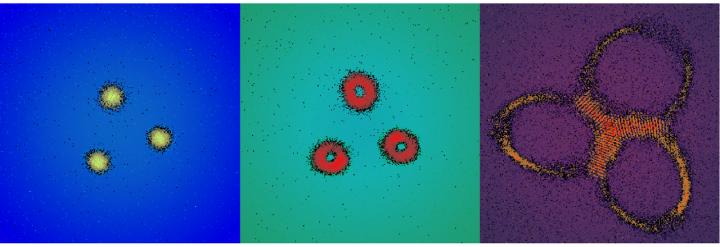

These three false-color images represent the quantum Hall state that University of Chicago physicists created by shining infrared laser light at specially configured mirrors. Achieving this state with light instead of matter was an important step in developing computing and other applications from quantum phenomena. In this quantum Hall state, particles of light mimic the orbital action of electrons in more standard experiments that involve powerful magnetic fields and ultra-cold conditions of near absolute zero (minus 459.6 degrees Fahrenheit).
Credit: Nathan Schine, Albert Ryou, Andrey Gromov, Ariel Sommer, and Jonathan Simon
Light and matter are typically viewed as distinct entities that follow their own, unique rules. Matter has mass and typically exhibits interactions with other matter, while light is massless and does not interact with itself. Yet, wave-particle duality tells us that matter and light both act sometimes like particles, and sometimes like waves.
Harnessing the shared wave nature of light and matter, researchers at the University of Chicago led by Neubauer Family Assistant Professor of Physics Jonathan Simon have used light to explore some of the most intriguing questions in the quantum mechanics of materials. The topic encompasses complex and non-intuitive phenomena that are often difficult to explain in non-technical language, but which carry important implications to specialists in the field.
In work published online June 6, 2016, in the journal Nature, Simon's group presents new experimental observations of a quantum Hall material near a singularity of curvature in space.
Quantum effects give rise to some of the most useful and promising properties of materials: they define standard units of measurement, give rise to superconductivity, and describe quantum computers. The quantum hall materials are one prominent example in which electrons are trapped in non-conducting circular orbits except at the edges of the material. There, electrons exhibit quantized resistance-free electrical conduction that is immune to disorder such as material impurities or surface defects.
Furthermore, electrons in quantum Hall materials do not transmit sound waves but instead have particle-like excitations, some of which are unlike any other particles ever discovered. Some of these materials also exhibit simultaneous quantum entanglement between millions of electrons, meaning that the electrons are so interconnected, the state of one instantly influences the state of all others. This combination of properties makes quantum Hall materials a promising platform for future quantum computation.
Researchers worldwide have spent the past 35 years delving into the mysteries of quantum Hall materials, but always in the same fundamental way. They use superconducting magnets to make very powerful magnetic fields and refrigerators to cool electronic samples to thousandths of a degree above absolute zero.
Trapping light…
In a new approach, Simon and his team demonstrated the creation of a quantum Hall material made up of light. “Using really good mirrors that are pointed at each other, we can trap light for a long time while it bounces back and forth many thousands of times between the mirrors,” explained graduate student Nathan Schine.
In the UChicago experiment, photons travel back and forth between mirrors, while their side-to-side motion mimics the behavior of massive particles like electrons. To emulate a strong magnetic field, the researchers created a non-planar arrangement of four mirrors that makes the light twist as it completes a round trip. The twisting motion causes the photons to move like charged particles in a magnetic field, even though there is no actual magnet present.
“We make the photons spin, which leads to a force that has the same effect as a magnetic field,” explained Schine. While the light is trapped, it behaves like the electrons in a quantum Hall material.
First, Simon's group demonstrated that they had a quantum Hall material of light. To do so, they shined infrared laser light at the mirrors. By varying the laser's frequency, Simon's team could map out precisely at which frequencies the laser was transmitted through the mirrors. These transmission frequencies, along with camera images of the transmitted light, gave a telltale signature of a quantum Hall state.
Next, the researchers took advantage of the precise control that advanced optical systems provide to place the photons in curved space, which has not been possible so far with electrons. In particular, they made the photons behave as if they resided on the surface of a cone.
…near a singularity
“We created a cone for light much like you might do by cutting a wedge of paper and taping the edges together,” said postdoctoral fellow Ariel Sommer, also a co-author of the paper. “In this case, we imposed a three-fold symmetry on our light, which essentially divides the plane into three wedges and forces the light to repeat itself on each wedge.”
The tip of a cone has infinite curvature–the singularity–so the researchers were able to study the effect of strong spatial curvature in a quantum Hall material. They observed that photons accumulated at the cone tip, confirming a previously untested theory of the quantum Hall effect in curved space.
Despite 20 years of interest, this is the first time an experiment has observed the behavior of quantum materials in curved space. “We are beginning to make our photons interact with each other,” said Schine. “This opens up many possibilities, such as making crystalline or exotic quantum liquid states of light. We can then see how they respond to spatial curvature.”
The researchers say this could be useful for characterizing a certain type of quantum computer that is built of quantum Hall materials.
“While quantum Hall materials were discovered in the eighties, they continue to reveal their fascinating secrets to this day,” said Simon. “The final frontier is exploring the interplay of these beautiful materials with the curvature of space. That is what we've begun to explore with our photons.”












